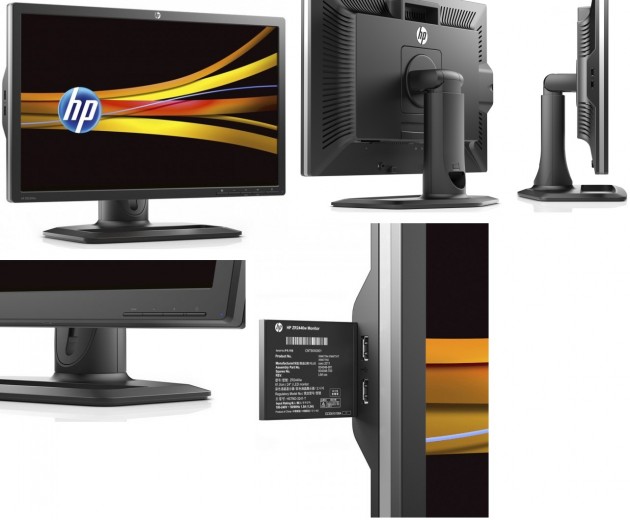Some things make viewing your 3D files easier. Like a monitor. Without it, you look pretty silly typing on a keyboard whilst pretending to adjust the screen brightness. Some things also make viewing your 3D files more enjoyable. This 27″ monitor from HP is one of them. It’s just a monitor sure, but if you’re in the midst of a decision to upgrade or have thrown your last one through the window (again), there are a few features on this monitor you’ll want to know about and how it compares to other smaller (and larger) screens.

HP ZR2740w 27″ Monitor
I’ve been using this monitor for the last few months. The ZR2740w monitor is a 27″ LED backlit IPS monitor. We’ll discuss what that means shortly. I actually have three monitors on my desk at the moment: a 24″ (ZR24w), a 27″ (ZR2740w) and a 30″ (ZR30w). This shiny, new 27″ monitor is an LED monitor, while the other two are LCD monitors. This being the first LED Monitor I’ve used, I was interested to find out just what the difference was.
Difference between LCD and LED monitors
An LED Monitor is an LCD Monitor. The difference is in how each is backlit. An LCD monitor uses CCFLs (cold compact florescent lights) to light the back of the LCD panel. An LED monitor uses blue LED’s coated with yellow phosphorous to backlight the LCD panel. LED backlit is simply a newer technology that provides brighter light/better contrast than the CCFL backlit screens. You may also notice a difference in color between an LCD and LED monitor. Out of the HP’s I have in my office and others I’ve compared, the LCD’s have a yellow hue, while the LED’s have a blue hue, providing a bit of a crisper look. Another difference is the heat dissipation. You won’t see it in the specs, but the LED screen’s put off much less heat. The amount of heat the 27″ LED screen put out was considerably less than my HP LCD 30″ screen and even less than my 24″ LCD screen. The 30″ put off enough heat to heat my office–Really—In the midst of winter with the heater off and one 36″ x 72″ window open, I was nice and toasty.
Design
If you’ve had any other HP monitors over the last couple years, you’ll not notice any drastic design changes. From the reinforced, plastic base to the plastic screen bezel, it’s basically identical, with a thicker lower bezel at the bottom of the screen. The monitor for the LED screen is, however, much thinner that it’s LCD counterparts, 2.7 inches (6.8cm) as opposed to 3.4 inches (8.7cm). The IPS (in-plane switching) screen has 2,560 x 1,440 resolution and great anti-glare properties, sharp colors and very clear viewing angles. However, the ZR2740w LED monitor has fewer ports–4 USB (two bottom, two side), 1 DisplayPort and 1 DVI–and the standard base of late with cord feed-thru and a handy little area to throw your pens, iPods or pastries.
Operation
While this is “just a monitor”, it’s the first one I’ve used that didn’t require any setup or tweaking after plugging it in. Typically, you’ll want to do some optimization on the color settings or power consumption, but the defaults for the ZR2740w are just about perfect. I already had the DisplayPort cable and it has worked great since plugging it in over three months ago. The monitor doesn’t come with any on-screen display (OSD) to adjust brightness, contrast, keystone, alignment, etc. What I’ve found though, is that you can adjust your color setting through most video cards options. For anything else, you’re out of luck. I’ve not had any backlight bleed off with this monitor and the response for 3D modeling, rendering and animation is very, very smooth.
Pros:
- Great resolution (2,560×1,440)
- Low heat output
- Carry handle
- Cable feed-thru
Cons:
- No OSD
- No HDMI
- No Ambient light sensor
- No touch capability
- No speakers
Price
Currently, you’ll find this monitor online between $650 and $700. You get three-year parts, labor and on-site service warranty, but this price doesn’t include the DisplayPort or DVI connectors/adapters. DisplayPort cables have come down in price–you can grab one on Amazon for $8.00.
Conclusion
I’ve used several HP Monitors in the past, some larger, some smaller than this 27″ LED monitor. I thought I would miss my 30″ screen, but the heat it put out was nearly unbearable. The ZR2740w made the environment in my office much nicer and the colors in front of my face much clearer. The resolution cranked all the way up still provides a clear, crisp view of the files, 3D models, graphics and has even helped me catch some additional detail on my renderings to help improve the final output. For 3D modeling or media creation this monitor is simply a joy to have, especially when compared to other LCD Monitors. My only request to HP is to keep the OSD option or at least provide monitor setting and optimization among their software offerings. I’d also add, even though inputs/outputs are constantly changing, don’t skimp on the USB port options.

![A Big Monitor for Your Small Office. The HP ZR2740w [Review]](https://www.solidsmack.com/wp-content/uploads/2012/08/hp-zr2740w-led.jpg)






